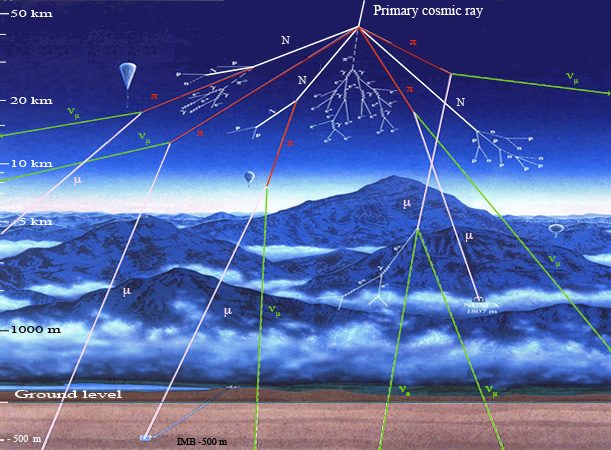Muons in the atmosphere, a component of cosmic rays
Atmospheric muons are an essential component of cosmic ray showers. When a high energy primary particle coming from space collides with a nucleus of the upper atmosphere, it generates a spray of particles which later interact in their turn. Among these secondary particles are short lived positive or negative pi mesons that decay into positive or negative muons.
The average lifetime of a muon is 2 microseconds (millionth of a second). This 2 microsecond lifetime may seem extremely short, but it is sufficient to allow muons to travel long distances in the atmosphere. Indeed most of the cosmic muons have a high energy and travel at speeds close to 300 000 km / second the speed of light in vacuum.
A 1 GeV muon (1000 MeV) would travel an average 6 km 87 in the atmosphere; a 10 GeV muon 63 km. The muon lengthening journey with energy is due to the time dilation predicted by the Einstein relativity theory. Very energetic muons may even go faster than the speed of light in the atmosphere. Such muons emits a flash of Cherenkov light that facilitates their detection.

Atmospheric muons
This cosmic shower diagram explains the production of muons (shown in white). A primary cosmic ray interaction is followed by several secondary interactions leading to charged pi mesons production (in red). After a rather long path because they are energetic, pi mesons decay into a muon and a neutrino (in green). Most muons reach the ground level. Some disintegrate in flight to give an electron (or positron) plus two neutrinos.
© IN2P3
During its journey, the muon has little chance to interact. Being 207 times heavier than electrons, it is much less subject to the Bremsstrahlung effect which is the main source of deceleration for electrons and positrons of similar energy. When travelling through matter, a muon sees he electrons of atomic clouds as true lightweights ! The energy loss by ionization is minimal.
Having survived and interacted little, cosmic muons travel far and easily reach the ground level. Some can be detected at depths below 500 meters, sites of some underground experiments. These are the only charged particles able to be observed there.
The bulk of cosmic rays reaching the sea level is due to muons, other particles (except neutrinos) being mainly stopped or absorbed by the atmosphere. At sea level, the flow of muons is about 170 muons per m2 and second, so humans are crossed by thirty muons per second. Each muon is accompanied by three neutrinos for which we are transparent.